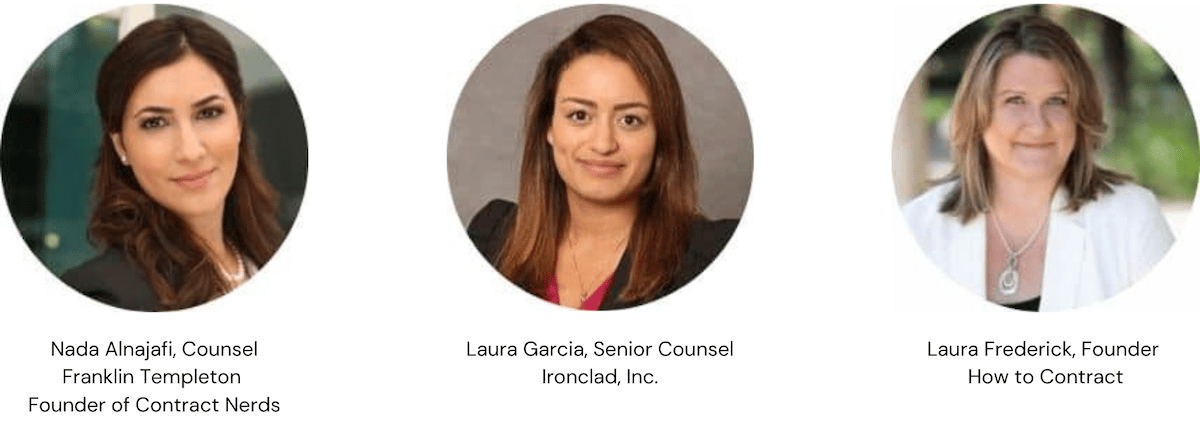Frustration. Stagnation. Speculation.
Contract negotiation is a necessary, but not always enjoyable, part of many deals. In a recent webinar, Ironclad’s Head of Community Development, Alex Su, talked to contracting experts about how to make the most of negotiations.
Laura Frederick, Nada Aljanafi, and Laura Garcia shared their tips on pushing contracts across the finish line as efficiently as possible.
You can watch the entire webinar or read on to get these leaders’ go-to contract negotiation tips.
1. If you can, skip negotiations
The easiest contracts to negotiate are the ones with no negotiation. Putting your foot down upfront (or playing by someone else’s PDF) doesn’t fit every scenario, though.
Establish no-negotiation thresholds
Laura Garcia, Senior Counsel at Ironclad, shared that Ironclad has a no-negotiation threshold.
“You can provide a PDF for customers under a certain threshold,” Laura Garcia shared. Higher-revenue clients will still likely require redlining and negotiations.
Tell customers upfront about non-negotiable PDFs
If you decide to leverage standard agreements for smaller projects, alert customers early in the process. Laura Frederick, the Founder and CEO of How to Contract, noted that,
“If you plan to send a PDF, your business relationship person should alert the customer that it’s non-negotiable. That way, it doesn’t come from the lawyer.”
It’s always best to give clients insight into your contracting process upfront. “I train procurement teams to discuss the contract during the vendor selection process. It’s important not to catch them off guard, so the first time they’re hearing about it isn’t so far down the line that legal is reviewing,” Nada Aljanafi, the Founder and Counsel at Contract Nerds, said.
2. Know what you can and can’t agree to
If negotiations are on the table, you need to understand your boundaries before entertaining client redlines.
Laura Frederick noted that “we all mostly negotiate to industry standards. But many companies have a particular thing they don’t negotiate on, even though it’s market. Knowing those in advance and [telling] the counterparty helps move things along quicker.”
A contract lifecycle management tool (CLM) helps you keep track of what you can and can’t agree to, plus regulations you need to be mindful of.
Laura continued, “A CLM is a great tool for compliance because you have insight into your contracts. Let’s say the state says you can’t have a term longer than X. With [a CLM], you can figure out what’s in your existing contracts and which ones must be amended. Whereas if you just have a big file folder in SharePoint with 300 documents that nobody’s looked at, it will be a big lift.”
3. Leverage templates and CLM intake forms
Using contract templates is a best practice that each webinar participant recommends, even if you anticipate negotiations or third-party paper.
Create templates for common contracts
“I like to have a set of standard templates based on what the business needs most often,” Nada suggested. Even if you need to adjust the contract, having a thorough starting point saves time.
Common contract templates include:
Use templates for gap analysis
Contract templates even help your negotiation process when you’re using third-party paper. Laura Frederick suggests comparing outside contracts to your templates for review.
“If you have a template that covers similar concepts, and you’re going to have to use that third-party paper, you really do need gap analysis. Even if it’s informal, 15 minutes looking at them side by side, you should have an idea of how their paper deviates from your standard practice.”
If you find differences between your template and a third-party one, it helps to think strategically about how you present edits.
“When you’re changing a third-party template, I recommend making sure that you’re drafting the clause to fit into their template,” Nada shared.
“You want to propose redlines that take up the least resistance from the other side. That means it’s not only a reasonable ask, and you’ve explained why you’re asking for this change, but you’ve also already drafted it for them in a way that matches the template. They don’t feel like they have to go in and do all of this work—just to say yes to you.”
You can attach custom statements of work to standard templates
If you love the idea of streamlining negotiations with standard templates, but your deals are custom, there are still ways to save time.
“In a previous role, we used one master consulting agreement for various businesses,” Laura Garcia shared.
“And the way we did that was to consolidate the Master Agreement, and then everything that sat underneath that was business specific, we would try to place it in a statement of work.”
Automatic intake forms pre-fill templates
A contracting lifecycle management tool (CLM) helps across the entire negotiation process, but one of Nada’s favorite features are intake forms.
She shared, “It gives you so much information from your internal business client about the deal. Before using CLM, it would take multiple meetings with different business clients about the contract, and maybe different people say different things. The intake form at the front end tells you everything about what the business client is looking for. Some CLMs connect intake forms and templates and draft the template for you.”
4. Talk across department lines
Different priorities, vocabularies, and workflows can set separate departments on diverging courses. Alex Su shared a story about encountering a misaligned legal and business team:
“I was negotiating an influencer agreement, and [the client] sent me a template. There was all this stuff about termination of convenience, which I didn’t understand for a TikTok video. So I spoke with them. And it turns out there was a disconnect between the legal and business teams because they typically used this contract for larger scale productions, not a TikTok.“
Better communication across department lines helps everyone achieve their goals, but coordinating everyone’s schedules is tough. Nada recommends regularly scheduled check-ins to ensure legal and business teams are on the same page.
“I like to have regular meetings with my internal business clients, especially the ones that frequently submit contracts to the team. Maybe every quarter or every six months, ask them firsthand, ‘What do you see as the pain point?’ Sometimes, their team needs to complete commercial negotiations before sending the contract in because that’s one of the reasons they haven’t solidified the deal yet. Sometimes they need access to the templates, and it takes too long to get it from legal, and we need to create access to the database just for that group.”
5. Use organization and communication to handle redlines
“Sometimes we see redlining as a quick technical thing that we have to do to communicate what we want to say. In reality, the redlines are where we negotiate the heart of the contract,” Nada shared.
Don’t leave redlines up to assumptions
Since redlines alter the very nature of a contract, it’s best to eliminate any assumptions.
“My number one redlining tip is to leave an explanatory note with your redline,” Nada noted. “Tell your party why you’re proposing the change, the story behind it, and the reasoning behind it. Be proactive about that to reduce the number of back and forth.”
Some of the information that Nada likes to pass along, particularly if the client doesn’t have an in-house attorney, include:
- How to add redlines
- Why she’s making changes
- How the redlining process affects negotiation
Keep everyone focused on relevant redlines
Redlines can quickly become overwhelming, especially as negotiations continue and more stakeholders get involved.
That’s why it’s critical to keep everyone focused on what matters to them at that moment.
One way Laura Frederick manages redlines is by clearing out resolved clauses. “I’ve had people say they like to keep track of which issues are closed. But the problem is, you see all these changes. And the psychology of it is, ‘Well, I already gave them all these things. Why am I going to give them some more?’ And by putting those away out of sight, out of mind, you say, ‘Oh, we’ve only got six things to resolve.’ And it’s easy to see how close you are to the end.”
A CLM also helps you bring in stakeholders without making them feel daunted by the volume of redlines.
Laura Garcia said that “it helps get things together on one platform and tag folks. So if InfoSec needs to review a particular area, you can tag your InfoSec. And they’re reviewing that simultaneously while you’re reviewing the section that you need to review. “
Laura also likes to use color coding to keep everyone focused.
“When I share the document with them, I can say, ‘Don’t worry about all this stuff; just focus on the two items highlighted in blue for you.’ And that calms them down, and it brings their focus to the right areas so we can have a good conversation about what’s needed.”
Bring up hidden changes in the final version
After all the back and forth, you receive the final version of a contract. There’s just one problem—there’s a hidden change. Nada suggests that if it’s not material, let it go. If It’s a significant change, bring it up to your client.
There’s always a chance it was simple human error, in which case a CLM could have helped.
“I’ve made mistakes in my career where I sent the wrong redline. I said I was comparing document A against Document B. But really, it was document C against Document B,” Laura Frederick said. A CLM lets you accurately manage contract versions so that nothing slips through the cracks.
6. Regularly review your pipeline
There’s always room for process improvement. In addition to regularly meeting with internal clients about their pain points, contract metadata helps you find weak points in your process.
Laura Garcia shared that “with Ironclad, we can see the contract metadata to understand if there are certain provisions that are causing more outlines, or if one specific template has a higher redline rate than other templates in prior versions. Then you can have an internal meeting to build upon that document to reduce the redline rate. You can see how long it’s taking you to negotiate certain deals within days or weeks. And where was the pain?”
7. Have empathy
“I am not an adversarial counsel—that’s not what contract lawyers are there to do. We’re here to get the deal done. If you think you’re winning by getting your point across, and you know, you’re going to win this one particular clause; you’re losing,” Laura Garcia shared.
A common topic across the panelists was having empathy for your contract counterparts.
Laura Frederick added,
“Have empathy even when you disagree completely. It’s not just empathy for people who agree with you or can make concessions. Challenge yourself to be empathetic with people who, for example, won’t change anything and say a hard no. Consider that maybe their bosses have told them they couldn’t change anything. What can I do to make this easier for them? It could be getting them to help you solve the problem.”
Even an act as simple as asking for the reasoning behind a clause rather than assuming it’s nefarious or unfounded creates a better negotiation environment.
8. Balance speed and risk
In an ideal world, you could quickly negotiate and get everything you want from an agreement. We don’t live in a perfect world, however. Often, contract managers have to work with their internal and external stakeholders to balance speed and risk.
“The key is to remember that a contract is a risk mitigation device and a tool for our business; it’s not an end to itself. So while it may feel great to negotiate that perfect indemnity, the delay is a risk,” Laura Frederick noted.
As you decide what to push, consider the risk not just in the redlines but also in the relationship.
Laura Garcia recognizes that a contract manager’s role is to act as a guide for the organization. “I will advise you frankly and honestly about the risks of whatever decision we’re trying to make to get the deal done quicker. I want to educate you about what that is going to mean in real life,” she said.
Want more contracting advice? Watch the entire webinar here and check out How to Contract and Contract Nerds.
Ironclad is not a law firm, and this post does not constitute or contain legal advice. To evaluate the accuracy, sufficiency, or reliability of the ideas and guidance reflected here, or the applicability of these materials to your business, you should consult with a licensed attorney. Use of and access to any of the resources contained within Ironclad’s site do not create an attorney-client relationship between the user and Ironclad.
- 1. If you can, skip negotiations
- 2. Know what you can and can’t agree to
- 3. Leverage templates and CLM intake forms
- 4. Talk across department lines
- 5. Use organization and communication to handle redlines
- 6. Regularly review your pipeline
- 7. Have empathy
- 8. Balance speed and risk
Want more content like this? Sign up for our monthly newsletter.




